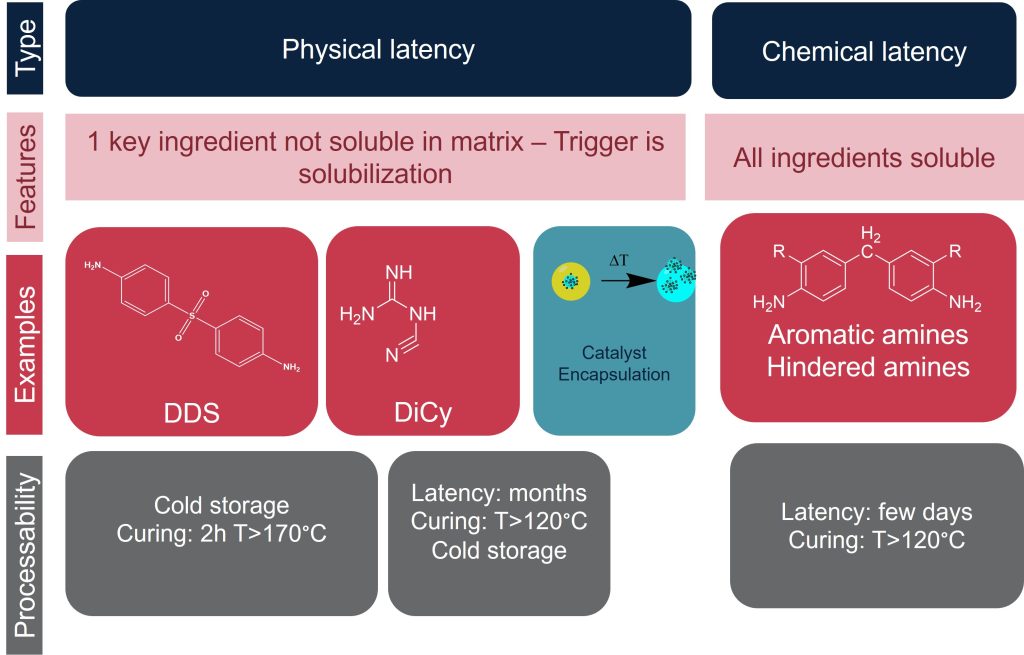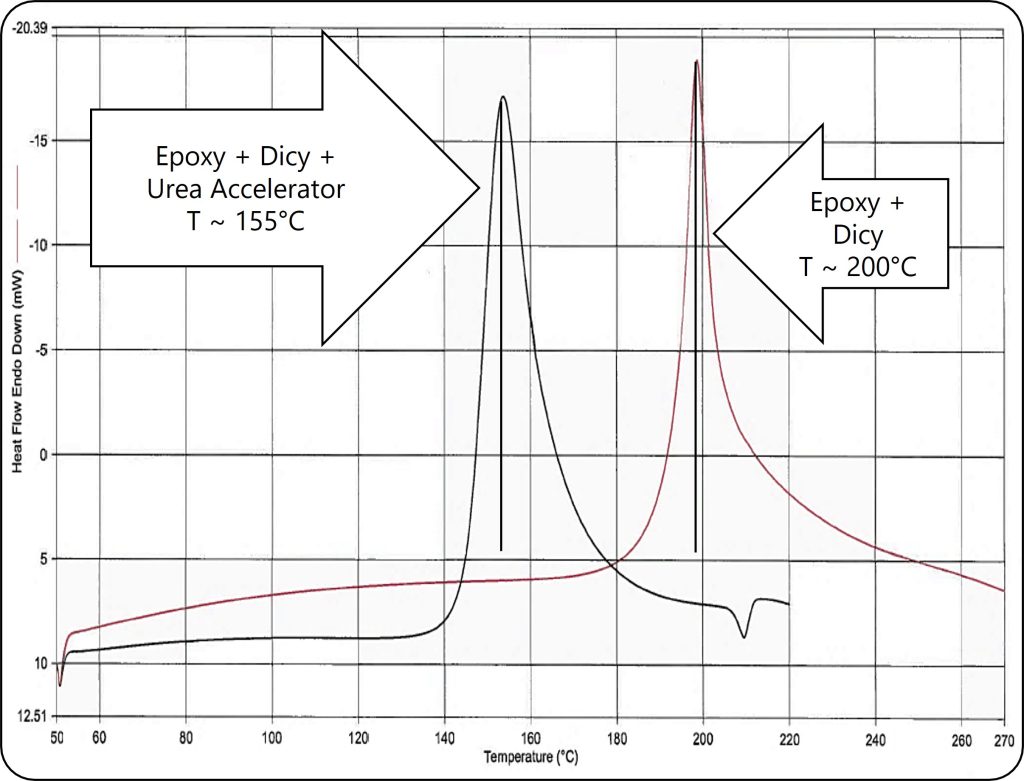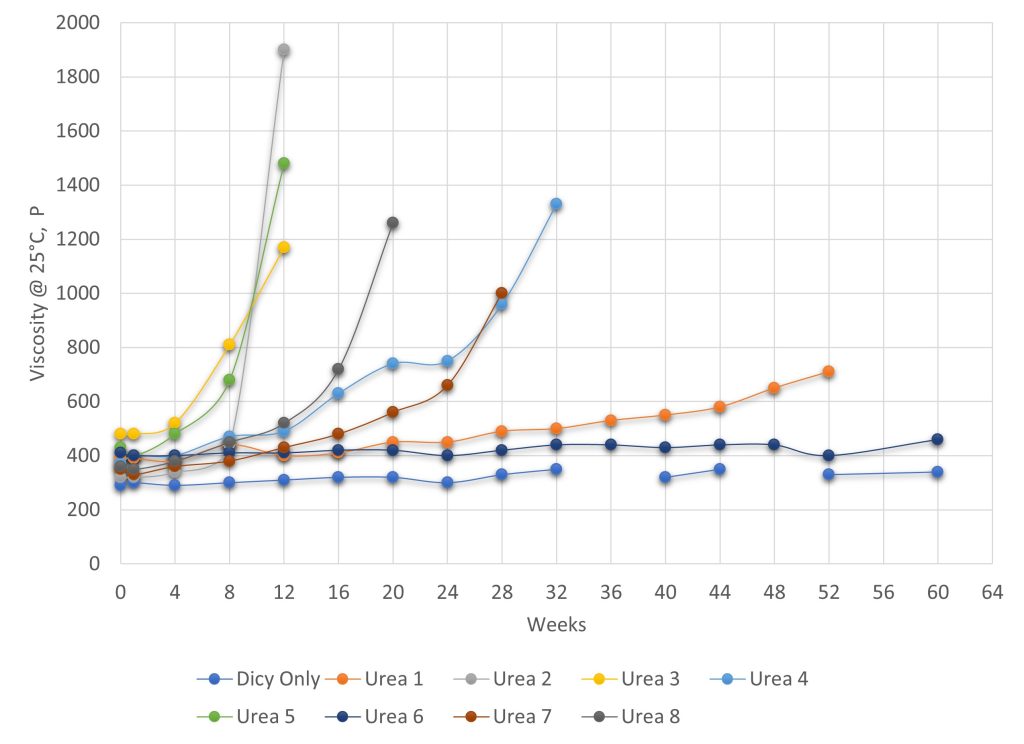Guest Post by Jeremy Pasatta, Advanced Polymer Coatings
All the epoxy curing agents in the last set of blog posts (amines, mercaptans and anhydrides) required mixing of the epoxy with the curing agent just prior to curing and are therefore considered two component formulations. The common element between all these curing agents is that they immediately start reacting with the epoxy resin and have a limited pot life, anywhere between 5 minutes and one day. Latent curing agents however can be mixed with epoxy resins, and because the rate of reactivity at room temperature is very slow, these formulations can be stored at room temperature for weeks or even up to one year without significant increase in the formulation viscosity. When exposed to elevated temperatures however the latent curing agents become very reactive with the epoxy and cure the formulation ranging from times of 5 minutes to 60 minutes. The latency can come from the curing agent either being insoluble in the epoxy resin and only dispersed in the formulation, or it can be soluble and extremely unreactive at room temperature. Table 1 summarizes the differences between physical and chemical latency.
Table 1. Physical Latency vs. Chemical Latency
Some of the main advantages of latent curing agents include the following:
- High Tg
- Activated by heat (cure on demand)
- Curing temperatures can be lowered with accelerators
- One component, no need for mixing before application
- Not affected by improper mixing of Part A and B
- Usually requires only catalytic amounts (5 – 10 phr)
One of the most widely used latent curing agents in both epoxy adhesives and composites is dicyandiamide, commonly referred to as dicy, the structure of which is shown in Table 1. Dicy, like other curing agents, is commonly micronized to reduce and control the particle size, which aids not only in dispersibility but also with reactivity. In general, the smaller the particle size, the more surface area that is available to solubilize, and thus the more reactive the latent curing agent will be. Typical particle sizes for micronized dicy are 5 or 10 µm. The peak curing temperature of dicy with epoxy resin is around 200°C, and cures within 30 minutes at this temperature. This curing temperature is often too high for many industrial processes such as structural automotive adhesives or prepregs, so a urea accelerator is often added to reduce this peak curing temperature. The temperature can be reduced from 200°C to as low as 150°C. A typical loading level for epoxies would be 8 phr of dicy and 3 phr of a urea accelerator. Figure 1 shows a DSC scan for an epoxy resin containing only dicy and a combination of dicy and urea accelerator, and clearly demonstrates the reduction in peak curing temperature.
Figure 1. DSC Plot of Epoxy with Dicy and Combination of Dicy with Urea
There are several different structures of urea accelerator that exist, each with a different balance of reactivity and latency. In general, the higher the reactivity (or reduction in peak exotherm temperature), the shorter the latency or shelf life. Figure 2 gives a comparison of eight different urea structures that were mixed with epoxy resin and dicy and held at room temperature and monitored for viscosity increase. The formulation with just epoxy and dicy shows no viscosity increase over 60 weeks at room temperature, and there are some urea structures that give similar stability performance, while some urea structures increase in viscosity after only 8 weeks. In general, the urea structures that increase in viscosity at 8 weeks when mixed with dicy and urea also give the lowest onset curing temperature.
Figure 2. Stability of Dicy / Urea Accelerator Combinations
If there is a process that requires snap cure at temperatures lower than 100°C, the structure of the amine shown in Figure 3 can accomplish just that in addition to giving extremely long latency.
Figure 3. Latent Solid Amine for Low Curing Temperature and Long Latency
With the amine structure shown in Figure 3, it is possible to obtain 95% conversion of epoxy in 10 minutes at 110°C, and 90% conversion in approximately 25 minutes at 80°C. There is no combination of dicy and urea that can cure epoxies in that short of time frame at that low of a temperature.
Latent curing agents are clearly the choice for one component heat activated epoxy systems. Latency is achieved through either physical insolubility or lack of chemical reactivity at room temperature, and the reactivity, solubility, and latency all must be carefully balanced. In the next blog post, we’ll take a look at biobased curing agents for epoxy resin, which is becoming an ever-increasing need for formulators to achieve sustainability of their products.





Hi
Very interesting article on 9/12/22 on latent curing by Jeremy Pasatta. Who supplies the latent curing agent described in the article that works at 80 and 90C?
Is the curing agent in Figure 3 commercially avalaible?
Is curing agent in Figure 3 commercially available?
Yunjun Li, I have stumbled upon a substance with o-phenylidene as R. Its CAS number is 68003-28-1.
Epoxy curing agents are the unsung heroes behind strong epoxy systems, and Polymer Innovation Blog does a fantastic job explaining them. Understanding latent curing agents is crucial for achieving desired results. This post simplifies the complexities and serves as a valuable resource for epoxy enthusiasts and professionals.